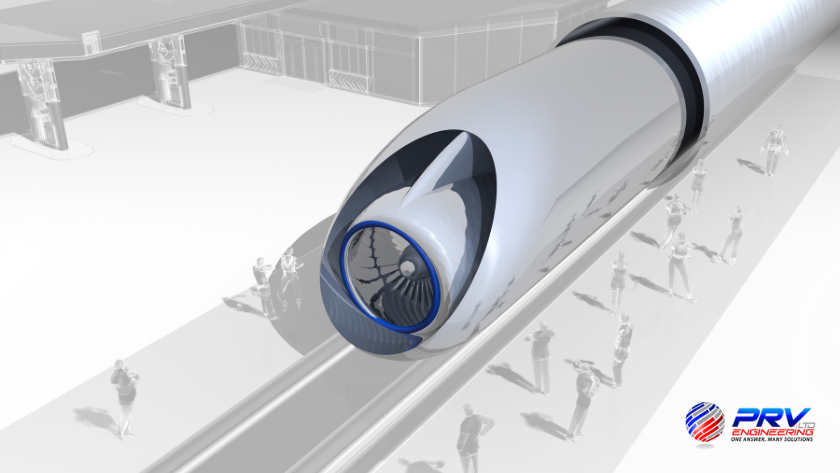
The idea behind a hyperloop network is not a new concept as many companies are working on the technology. This includes Virgin, Elon Musk, vacuum tube pioneers Leybold and engineering company AECOM. But now there’s another project on the cards with Hyperloop Italia and Zaha Hadid Architects.
Planning The Near-Supersonic Hyperloop Network
With technology advancing at such a rapid pace, we are one step closer to realising the future of transportation. Zaha Hadid Architects (ZHA) has signed a partnership agreement with Hyperloop Italia to design the new near-supersonic hyperloop network in Italy.
Not much has been revealed about what exactly the partnership will entail but ZHA has confirmed that the companies will collaborate on the “next phase of works”. Whilst there’s no indication of location, Hyperloop Italia revealed one possible route from Milan to Malpensa Airport. The new hyperloop network would shorten the usual 40-minute journey to just 10 minutes.
It seems ZHA and Hyperloop Italia share the same multidisciplinary approach which combines innovation in design and operational technologies with advances in ecologically sound materials and construction practices.
This will allow them to “deliver inventive, structurally efficient, and environmentally sustainable future-ready projects,” according to ZHA’s Principal Patrik Schumacher.
Building The Hyperloop Network In Italy
Initial plans suggest the hyperloop network in Italy will only run on renewable energy where it will produce more energy than it consumes with the help of regenerative braking systems. Filippo Innocenti, Director of ZHA, stated that their “designs look to the future with great consideration to the environment and all our communities.”
The Italian hyperloop network will operate similarly to other systems around the world. It will feature two low-pressure tubes that propel magnetically levitated cargo and passenger capsules with dimensions of 65 feet (20m) in length, 8.8 feet (2.7m) in width. According to sources, the speed of the hyperloop could reach up to 760 mph (1,223 km/h) which is just tremendous.
ZHA highlighted the fact that hyperloop systems only require a small amount of energy to power traditional methods of transportation. Furthermore, the next-gen hyperloop capsules will provide passengers (and cargo) a much smoother, faster, and environmentally-friendly ride.
Why Hyperloop Italia Partnered With ZHA Achievements
Zaha Hadid Architect’s partnership with Hyperloop Italia adds to the company’s three decades of experience with civic and cultural buildings. This includes the MAXXI Museum in Rome and the London 2012 Olympic Aquatics Centre.
However, it’s the fact that ZHA has built several award-winning transportation infrastructures across the world that favours the London-based architecture company. Some of their most impressive projects include the following:
- Hungerburg Nordpark mountain railway in Austria
- Napoli-Afragola high-speed railway station
- Beijing Daxing International Airport
- KAFD interchange station of the new Riyadh metro system
- The landmark Sheikh Zayed Bridge in Abu Dhabi and the Danjiang Bridge are currently under construction
The History Of Vacuum-Tube Transit Systems (Hyperloop)
The concept behind fast transportation started as early as 1845 with a vacuum tube transit system from a British engineer. Isambard Kingdom Brunel was the Elon Musk of his time who proposed building a tube in southwest England that would allow trains to travel 70 mph (110 km/h). Unfortunately, they abandoned the project as it proved unfeasible due to a lack of materials that would sustain it.
Today, almost 180 years since Brunnel’s attempt, Tesla and SpaceX CEO Elon Musk and other companies such as Virgin have placed this technology firmly in the spotlight. In 2013, Musk published a 58-page technical paper outlining the design of Hyperloop, a solar-powered transportation system. In the document, he described it as “a cross between a Concorde, a railgun and an air hockey table.”
How Does Hyperloop Work?
A hyperloop system primarily focuses on removing the two things that slow down regular vehicles – friction and air resistance. To avoid friction, a hyperloop pod must hover above its track becoming a magnetic levitation or maglev train.
In layman’s terms, maglev trains use one set of magnets to repel and push the train up off the track. At the same time, another set moves the “floating” train forward. When the two sets of magnetic waves are established, they work together to push the vehicle forward by taking advantage of the lack of friction.
For a hyperloop network to achieve the near-supersonic speed, it has to drastically minimise air resistance. That’s where a low-pressure sealed tube comes in which sucks out nearly all the air; similar to conditions at about 200,000 feet (61,000 meters) above sea level.
Recommended: ‘Hyperloop Systems From Around The World’
Final Thoughts On The Hyperloop Network
Hyperloop networks are gaining traction around the globe with one example being Virgin Hyperloop. Earlier this year, they shared an animated video showing what its future capsules, stations, and systems would resemble.
Another hyperloop network is South Korea’s hyper-tube train which works in a similar way reaching speeds of up to 621 mph (1,000 km/h). Whichever system you look at, they all belong in a sci-fi movie and a fascinating area of interest. We, for one, can’t wait to see such a hyperloop network in action.
PRV Engineering has been a supplier of precision engineering and custom fabrication services to several industries, including rail, defence, aerospace, oil and gas, construction and automotive. We know a thing or two about engineering and technology so we regularly share fascinating articles on some of the latest developments. Please feel free to read and share posts from our weekly blog.


 Mail:
Mail: 



